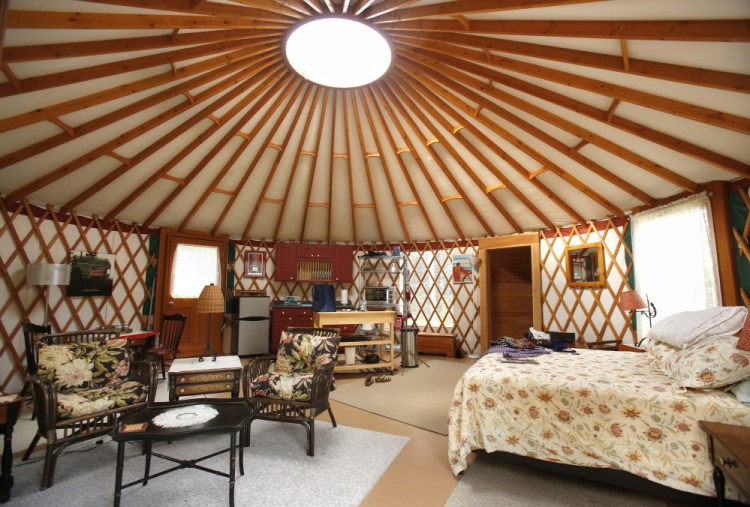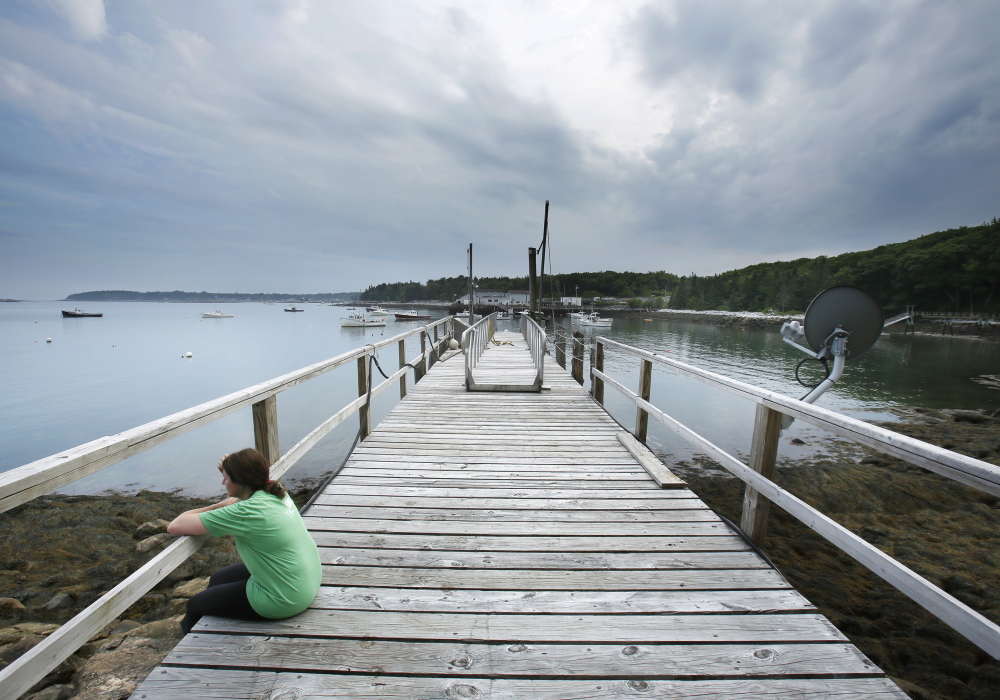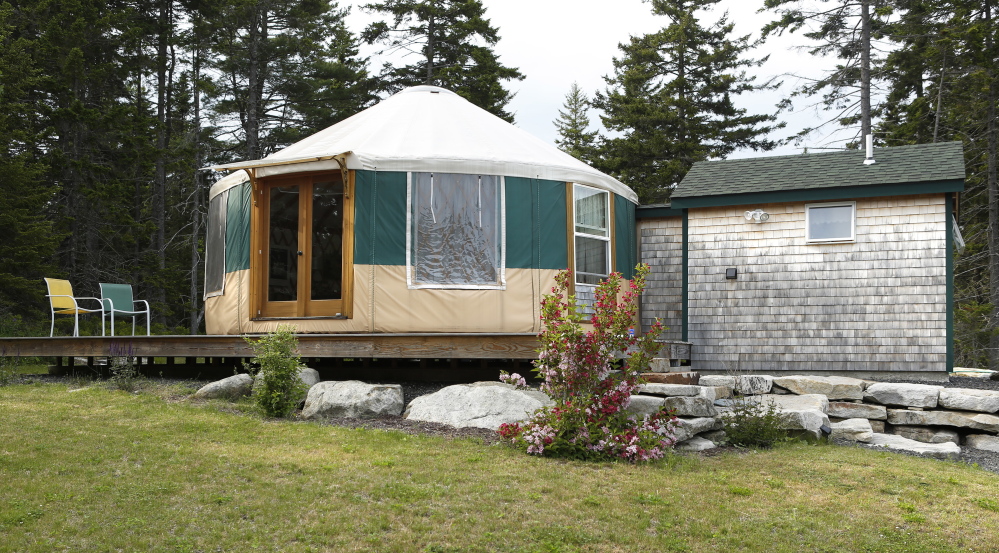My yurt was so posh, it might have exceeded even glamping. It was more like poshamping.
Glamping is the cute term for upgraded camping, ie glamorous camping. Yurts qualify because they are tents heavy on creature comforts. They won’t blow over in a gust, but still represent a semi-portable kind of life and, of course, the wandering ways of the Mongolian nomads, whose movements across the land in search of places for their livestock to graze represent the ultimate quest for sustainability. Or, as they might call it, survival.
This being America, yurts are less about survival than having an outdoors overnight experience that doesn’t involve inflatable mattresses or trying to remember how to put the tent together. I’ve had fantasies about this phenomenon, most inspired by photo spreads in Vogue and Sunset magazines. My ideal glamping setting varies – Alaska (if it’s not raining), Africa (if I can somehow skip the rich man-poor man guilt) and deserted Maine islands (if every mosquito and tick and black fly has been slain in advance of my arrival). All involve candles burning at dusk that light up the heavy canvas tent from within.
In these fantasies, I’m much younger and my L.L. Bean-clad boyfriend and I are debating (lovingly, oh so lovingly) whether we should name the first dog or baby Juniper or Lupine. We also have on chunky eyeglasses that shouldn’t be flattering but somehow are. We care deeply about the environment, and Juniper or Lupine will be born at home, in the tub, unless of course, she or he is a puppy.
My expectations as I approached my yurt-for-the-night just north of Tenant’s Harbor were much simpler. I wanted to look out at boats on the water and be alone. No mosquitoes, ticks or people (just my dog; the owner allows pets for a deposit). No leaks in a storm, no RVs in sight and, in the best scenario, a flush toilet on the premises. These were, to my mind, the main draws of yurts.
I was almost to the end of State’s Point Road, a long dirt road lined with a mix of new vacation homes and older cottages, before I spotted the yurt, perched on a ledge behind an equally incongruous warehouse/misplaced marine building. The yurt, as is generally the case, had been built on top of a wooden platform. I sat on the edge of the platform, which made a nice deck, to contemplate the view. Woods, weeds and no water in sight. There was a lobster boat, only it was up on stilts. Mosquitoes greeted me like a long lost mother.
We all must make compromises.
The interior of the yurt was clean and inviting. A lattice that helped support the canvas walls gave it a bit of an Alpine look (although it’s actually Mongolian) while the lacquered black furnishings spoke more to the Bombay Trading Company catalogue. The queen bed was as comfortable as mine at home and had been made with cotton sheets that spoke of high thread counts. A kitchen area had a small fridge, a toaster oven and a set of electric burners.
The bathroom was in an adjoining shed, which made me think my yurt was cheating on yurtdom, but cheating in style: blonde wood, washer and dryer, flush toilet, shower and stacks of clean towels.
I could totally live like this.
My research on yurts had led me to expect something comfortable but more modest, and even more fragile. On a website called movingtoayurt, I’d read that the drawbacks to yurts include issues with wildlife. “Squirrels…like raccoons, can wreak havoc on the tarpaulins.” My tarpaulins looked unscathed. I’d also thought I’d be off the grid. But there was a propane tank, firing the generator that fired the hot water heater and supplied juice to the electric outlets. I wasn’t sure I was helping sustain anything other than my own comfort.
When I returned, I called Bob Crowley, who runs Maine Forest Yurts in Durham, on the shores of Runaround Pond. I wanted to know if my posh yurt made me a dilettante in the world of sustainability. After all, Crowley won “Survivor” in 2008, so I considered him an expert on the topic of living green (except for the film crews).
A yurt, even a fancy yurt, is still low-impact, he said, “only slightly more impact than a tent.”
He was just putting the finishing touches on the second yurt he’s raised on his property. It has a gas stove and a bed, but no running water, although he supplies 10 gallons of washing-up water to guests. Maine Forest Yurts have LED lights and may in the future have solar panels, but are off the grid. The adjacent toilet is composting. (The same is true at Frost Mountain Yurts in Brownfield, which has four yurts to rent, and at Pagett Farm in Palermo. Pagett Farm also offers showers in the farmhouse, as well as a farm breakfast.) Maine Forest Yurts’ platforms and bed frames are built of recycled wood or come right from his woods. “A lot of these trees have never been on a truck,” Crowley said.
The main asset of a yurt, he said, is a clean camping experience: “It takes the dirt out of camping.”
That was true. My midcoast yurt was far cleaner than my car, for instance. And though it poured almost the entire night, the place stayed absolutely dry. I slept better there than I have in months; I woke at one point to the sound of thunder and rain pounding on the plastic shield in the central of the yurt roof, but it was a soothing sound. If it had been a starry night, Crowley reminded me, I would have had a window to the skies.
“There’s a direct connection to the land,” he said. “It’s also really beautiful to see the moon.”
He sees yurts as an important educational tool, a chance to get back to nature. He told me about a group of fifth-graders from South Portland who recently came for a field trip. “Are we still in the United States?” he overheard one child saying to another, as they got off the bus.
I had no questions about what nation, or state I was in – the noise of lobster boats in the early morning were a dead giveaway. But even with those electric outlets to charge my iPhone, I did feel off the grid. There was no wireless. I read an entire book and a magazine cover to cover in the course of my overnight stay. And though I saw not one person (except a Press Herald photographer) during my stay, inside the yurt structure, with its wood-framed glass doors and screened windows, I felt safe as houses. This yurt may have been something of a novelty, but getting away in a place where the fireflies were nearly as rampant as the mosquitoes and the phone stayed quiet? That was meaningful.
Send questions/comments to the editors.






Success. Please wait for the page to reload. If the page does not reload within 5 seconds, please refresh the page.
Enter your email and password to access comments.
Hi, to comment on stories you must . This profile is in addition to your subscription and website login.
Already have a commenting profile? .
Invalid username/password.
Please check your email to confirm and complete your registration.
Only subscribers are eligible to post comments. Please subscribe or login first for digital access. Here’s why.
Use the form below to reset your password. When you've submitted your account email, we will send an email with a reset code.